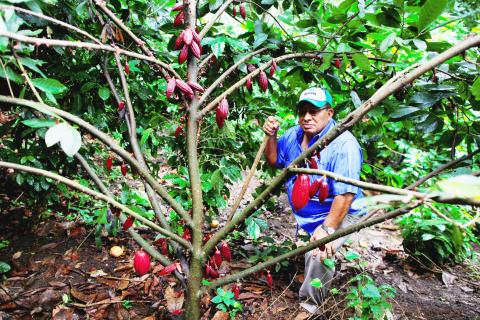Farmer Abelardo Ayala took a tough decision on his estate in San Juan Tepezontes, a traditional coffee-producing region of El Salvador: to swap his coffee trees for cocoa as a warming climate hit his crop.
Ayala said his plantation — situated between 600m and 1,000m above sea level in the south-central department of La Paz — had been ideal for growing coffee. However, with rising temperatures, production became difficult.
In the past four years, recurring drought, a plague of coffee borer beetles and other problems linked to climate shifts put his coffee plantation on the ropes.

Photo: Reuters
The farmer tried sowing varieties resistant to a widespread fungus called roya (coffee rust), which affects the leaves and harms bean production, but that failed to protect his harvest.
In low-lying areas, many producers have abandoned their crops, or sold their land to urban developers.
However, Ayala started to study the benefits of cocoa, including its low cost of production, good price on international markets and environmental value, such as protecting water basins and wildlife.

Photo: Reuters
“People here are starting to cultivate cocoa in zones where before there was coffee,” the farmer told the Thomson Reuters Foundation. “Drought and climate change are making it impossible to work with coffee, so we produce cocoa now.”
Mexico and Central America, which together produce one-fifth of the world’s Arabica coffee beans, have been hit hard by roya and the volatility of coffee prices in the last few years.
“The situation has led many producers to change from coffee to cocoa. It is happening step by step,” Nicaraguan farmer Luis Moreno said, referring to growers in Jinotega department, one of the nation’s principal coffee regions.
“Where they have coffee, they get a harvest and then take out [the plant] — so now they are left only with cocoa cultivation,” he said.
Moreno is technical coordinator for the People’s Community Action Association, which has been giving cocoa plants and technical help to small producers since 2014. He says the program has been a success so far.
The farmers find it cheaper to grow cocoa because it needs fewer workers and about 40 percent less investment in inputs than coffee, while international prices are buoyant.
“It is more profitable,” Moreno said.
According to VECO, a Belgium-based non-governmental organization that works with small-scale farmers in developing countries, Central America has about 25,000 cocoa producers, spread across Guatemala, Honduras, Nicaragua and El Salvador, growing cocoa on about 12,700 hectares.
VECO estimates cocoa production will expand to about 25,500 hectares in 2019.
“Many studies prove that coffee production will move higher up because of global warming,” VECO regional director Karen Janssens said. “For this reason, cocoa could be an alternative for producers whose estates are in lower zones.”
When the Spanish arrived in Mesoamerica in the early 1500s, they observed that indigenous people used cocoa seeds like currency.
Cocoa is a species native to the region and was cultivated by the Aztec, Mayan and Pipil people until the 19th century when coffee was introduced from Africa, largely replacing cocoa.
Salvadoran National Indigenous Coordinating Council member Nestor Perez said indigenous communities began re-introducing cocoa trees on their lands in 2014.
“We can see [this trend] not only from an economic or environmental point of view, but we can also link it with our cultural identity, because our people grew cocoa traditionally,” Perez said.
Indigenous peoples use cocoa to make chocolate, or in ceremonies where they burn cocoa seeds and chocolate in a wood fire to express gratitude to “Mother Earth” for the harvest.
However, while cocoa production may be better suited to low altitudes in a warmer world, the writing is not yet on the wall for coffee. Experts predict farmers will continue to produce coffee in mountainous areas, or adapt the way they cultivate it as the climate changes.
Some coffee producers are making an effort to revive their crop.
Francisco Flores Recinos, for example, has started planting cocoa and other fruit trees among his coffee plants to diversify production on his estate in Jayaque in central El Salvador.
Flores Recinos is growing about 4 hectares of cocoa interspersed with coffee as part of a project supported by the Salvadoran Ministry of Agriculture, which is helping more than 300 farmers cope with climate shifts.
“I thought of mixing cocoa and coffee in some areas of my estate where there was water nearby, before roya attacked,” the producer said.
If his coffee trees do suffer from roya, the profit from his cocoa crop will help cushion any losses, he added.

Nissan Motor Co has agreed to sell its global headquarters in Yokohama for ¥97 billion (US$630 million) to a group sponsored by Taiwanese autoparts maker Minth Group (敏實集團), as the struggling automaker seeks to shore up its financial position. The acquisition is led by a special purchase company managed by KJR Management Ltd, a Japanese real-estate unit of private equity giant KKR & Co, people familiar with the matter said. KJR said it would act as asset manager together with Mizuho Real Estate Management Co. Nissan is undergoing a broad cost-cutting campaign by eliminating jobs and shuttering plants as it grapples

PERSISTENT RUMORS: Nvidia’s CEO said the firm is not in talks to sell AI chips to China, but he would welcome a change in US policy barring the activity Nvidia Corp CEO Jensen Huang (黃仁勳) said his company is not in discussions to sell its Blackwell artificial intelligence (AI) chips to Chinese firms, waving off speculation it is trying to engineer a return to the world’s largest semiconductor market. Huang, who arrived in Taiwan yesterday ahead of meetings with longtime partner Taiwan Semiconductor Manufacturing Co (TSMC, 台積電), took the opportunity to clarify recent comments about the US-China AI race. The Nvidia head caused a stir in an interview this week with the Financial Times, in which he was quoted as saying “China will win” the AI race. Huang yesterday said

TEMPORARY TRUCE: China has made concessions to ease rare earth trade controls, among others, while Washington holds fire on a 100% tariff on all Chinese goods China is effectively suspending implementation of additional export controls on rare earth metals and terminating investigations targeting US companies in the semiconductor supply chain, the White House announced. The White House on Saturday issued a fact sheet outlining some details of the trade pact agreed to earlier in the week by US President Donald Trump and Chinese President Xi Jinping (習近平) that aimed to ease tensions between the world’s two largest economies. Under the deal, China is to issue general licenses valid for exports of rare earths, gallium, germanium, antimony and graphite “for the benefit of US end users and their suppliers

Dutch chipmaker Nexperia BV’s China unit yesterday said that it had established sufficient inventories of finished goods and works-in-progress, and that its supply chain remained secure and stable after its parent halted wafer supplies. The Dutch company suspended supplies of wafers to its Chinese assembly plant a week ago, calling it “a direct consequence of the local management’s recent failure to comply with the agreed contractual payment terms,” Reuters reported on Friday last week. Its China unit called Nexperia’s suspension “unilateral” and “extremely irresponsible,” adding that the Dutch parent’s claim about contractual payment was “misleading and highly deceptive,” according to a statement